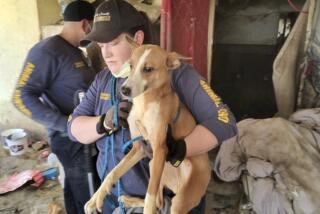L.A. County Sheriff’s Department probe finds dogs suffered sun burns; vet in disbelief
A preliminary finding that severe burns on nine dogs in the Lancaster area were caused by the sun, not a person targeting the stray animals, was met with outrage by one of the veterinarians who treated them.
Dr. Alan Schulman, a veterinary surgeon with years of experience in dermatological and reconstructive surgeries on animals, said there was no rational way authorities could conclude the injuries were caused by the sun, or “solar thermal necrosis.”
The preliminary findings were first reported by KNBC-TV Channel 4, which obtained an internal memo discussing the case shared among Los Angeles County Sheriff’s Department officials, said Lt. Steve Sylvies.
According to the memo, “both animal forensic experts and veterinary experts formed the opinion the dogs were not intentionally burnt, but suffering from burns caused by the sun, solar thermal necrosis,” NBC4 reported.
Sylvies said authorities haven’t ruled out foul play being involved in the dogs injuries -- burns running along the dogs’ spines and that occurred over about two months in the Lancaster area -- but that there was no evidence to support it.
“Unfortunately ... we’ve talked to our crime lab and [when] detecting these types of chemicals, there’s a very small window of opportunity to do that,” Sylvies said. “We can get 10 vets to look at the same dog and get two or three different causes.”
Sylvies said the dogs were strays and that there were some extremely high temperatures in Lancaster this summer. The dogs could have been sunburned until blisters formed on their backs, which would then become infected without treatment and shelter, Sylvies said.
But Schulman isn’t buying it.
“Are you kidding me? Is there a hole in the ozone layer directly over Lancaster that no one’s detected?” he quipped. “You’re going to tell me that throughout the entire Southwestern United States ... the only place it gets that hot and that dangerous is this tiny little community of Lancaster?”
A dog’s fur shields its skin from direct sunlight and radiation. Because dogs don’t have sweat glands over their entire body, they pant to stay cool. If the burns were caused by the sun, the dogs would have suffered heat stroke long before their backs were injured to the point some of them would have to be euthanized by animal control, Schulman said.
None of the dogs showed any heat-related injuries besides the burns, he said.
Schulman treated one of the dogs, a golden retriever named Fergus, extensively. He also saw three others. If it wasn’t chemicals that burned the dogs, he said, it may have been boiling water, which wouldn’t leave a chemical trace.
Authorities similarly reasoned the burns may not have been chemical because the dogs likely would have licked their wound or walked through the caustic substance, which would have burned their tongue or paws, NBC4 reported.
A 10th dog that was recently revealed to have been burned in 2012 was attacked with chemicals, Sylvies said. He urged the public to immediately alert authorities if they find more burned dogs, which could possibly steer the conclusion away from the sun.
“Hopefully, if there’s more similar-type injuries, it’ll be brought to our attention in an expedited manner so we can get some samples, some skin tissue,” he said.
County animal control declined to comment. A $50,000 reward remains in place for any information leading to a potential suspect in the dogs’ injuries.
Anyone with information is asked to call the Lancaster sheriff’s station at (661) 948-8466.
For breaking California news, follow @JosephSerna on Twitter.
ALSO:
Man shot and killed by sheriff’s deputies at San Gabriel Valley home
Drivers spend long night on road as mudslides engulf nearly 200 vehicles
1 killed, 3 hurt when L.A. sheriff’s deputies hit pedestrians while responding to call
More to Read
Sign up for Essential California
The most important California stories and recommendations in your inbox every morning.
You may occasionally receive promotional content from the Los Angeles Times.











